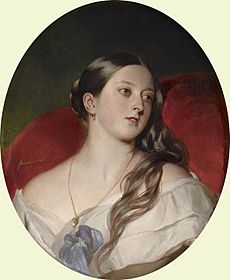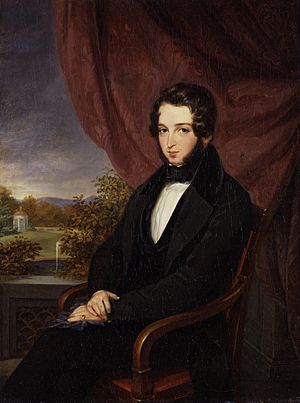British Relief Association facts for kids
| Founded | January 1847 |
|---|---|
| Founded at | London, England |
| Dissolved | July 1848 |
| Type | Famine relief |
|
Area served
|
Ireland and Scottish Highlands |
The British Association for the Relief of Distress in Ireland and the Highlands of Scotland, often called the British Relief Association (BRA), was a special charity group in the mid-1800s. It was set up in 1847 by important people like nobles, bankers, and generous helpers. This group became the biggest private helper during the terrible Great Irish Famine and the Highland Potato Famine in Scotland during the 1840s. Even though it only worked for a short time, many famous politicians and even Queen Victoria gave money and support to the Association.
Contents
How the Association Started
When a plant disease called potato blight first hit Ireland in 1845, some people started raising money. But when the blight returned much worse in 1846, a bigger effort was needed.
A Public Call for Help
On December 24, 1846, an Irishman named Nicholas Cummins wrote a public letter in The Times newspaper. This letter led to many donations from British business people and bankers. In just a few days, over £10,000 was collected! Because so much money came in, the British Relief Association was created. It was started by Baron Lionel de Rothschild to manage all the donations for famine relief.
First Meetings and Key People
The BRA had its first official meeting on January 1, 1847, at Baron de Rothschild's home in London. Rothschild had invited some of the richest and most important men in Britain. These included Mayer Amschel de Rothschild, John Abel Smith, and Samuel Gurney.
Later meetings were held at South Sea House in London. Other important people joined the committee, like Thomas Baring, 1st Earl of Northbrook and David Salomons. Stephen Spring Rice, one of the few Irish members, became the BRA's secretary. He knew firsthand about the potato blight's effects on his family's lands in Ireland. Each committee member gave at least £1,000 to the relief effort. They met every day to decide how to use the money.
Strong Connections
From the very beginning, the British Relief Association had strong connections with important politicians, especially the Whig Party. This helped the charity become well-known quickly. A kind Quaker named William Edward Forster praised the committee. He said they were truly committed to helping more than just by giving money.
The potato blight also affected Scotland in 1845 and 1846. So, the Association set aside one-sixth of its money to help people in the Scottish Highlands.
What the Association Did
Soon after the Association started, requests for help poured in from all over Ireland. The committee began asking transport companies for help. On January 4, 1847, P&O offered a steamship to carry food to Ireland for free. Other railway companies like the London & North Western Railway also offered free transport for aid.
Working with Others
Much of the help was sent through existing relief groups in Ireland. The BRA's members used their connections to encourage fundraising across the British Empire. The BRA worked closely with the British Government to make sure their efforts were coordinated. They wanted to help people the government couldn't reach.
A key person was Paweł Strzelecki, the Association's agent in Ireland. He sent regular reports about the suffering he saw. These reports were printed in British newspapers, showing the public how bad the situation was.
Aid Distribution
By March 1, 1847, Strzelecki had given aid to 65 places in Ireland. This included clothes, over a thousand bags of rice, and nearly two thousand barrels of meal. For example, by April 1, 1847, he had spent £2,953 in County Mayo. In Westport, County Mayo, about 8,000 people were fed weekly by the Association in 1847.
As more help was needed, Strzelecki became the Executive Director in May 1847. More volunteers joined to help. By summer 1847, a temporary plan was in place: soup kitchens across Ireland were feeding 3 million people a day. At this point, the BRA decided to reduce its own work. By the end of June, only Strzelecki remained in Ireland for the Association.
Continuing Help
In autumn 1847, the British government said the famine was over. They announced no more money from the government would be spent on relief. However, people still needed help. The Association used its remaining money to assist 22 areas in Ireland. For over eight months, about 200,000 children in Ireland received free daily food and clothing. By July 1848, the British Relief Association had used all its money and closed down.
In Scotland, the Association's help was managed by the Earl of Dalhousie and Lord Kinnaird.
Donations Received

In total, the British Relief Association raised about £500,000. This would be worth around £52.26 million today (in 2019). Over 15,000 individual donations were sent to the BRA. Each one was carefully recorded.
Royal Contributions
The first donation from outside the Association came from Queen Victoria. She had been criticized for not doing enough about the famine. Three days after the charity started, she donated £2,000. She had first sent £1,000, but the Association's secretary, Stephen Spring Rice, said it wasn't enough. The Queen then increased her donation. The next day, Prince Albert gave £500. Other royal family members also donated, including Adelaide of Saxe-Meiningen (£1,000) and Ernest Augustus, King of Hanover (£1,000).
Other Notable Donors
Other donations came from Abdülmecid I, who sent £1,000. Several British politicians also gave money, such as Lord John Russell (£300) and Sir Robert Peel (£200). Groups that donated included the Singapore Irish Relief Fund (£31) and the East India Company (£1,000). Even the journalists of Punch magazine, which was known for making fun of Ireland, sent £50.
The Association's committee included people from different religions, like Anglicans, Jews, and Roman Catholics. Donations from religious groups showed this diversity. Queen Victoria wrote public letters to Anglicans in March and October 1847. These appeals helped raise about £170,000 and £30,000 from Church of England churches. Other donations came from Methodist, Roman Catholic, and Baptist groups.
Many donations also came from overseas. Over £20,000 was sent from British North America. Even Abraham Lincoln, who was a young lawyer at the time, gave £5. The largest single donation came from the Bombay Relief Committee, which raised £10,177.


